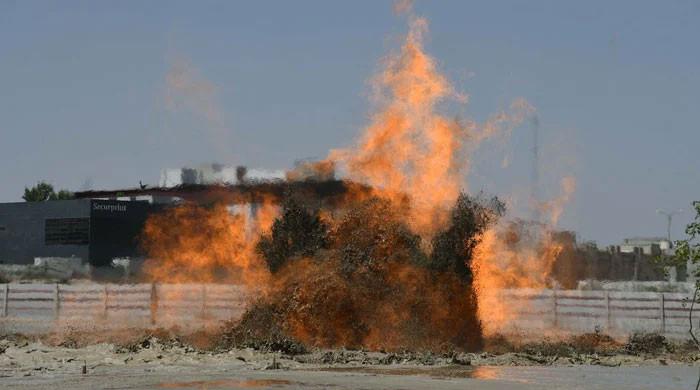Korangi Fire Finally Extinguished After 17 Days
- The fire initially broke out on March 29 during bore-drilling activities.
- Chemical analysis has indicated elevated levels of benzene and toluene.
- Authorities sought advice from a US firm specializing in well control.
The prolonged and enigmatic fire in Korangi has been put out, marking the conclusion of a 17-day ordeal.
Despite the fire being extinguished, gas is still being emitted from the site, leading to water eruptions. This water had been used by firefighters to suppress the flames.
The fire’s origin can be traced back to March 29, following the drilling of a 1,200-foot bore at the location. Concerns had risen regarding the nature and quantity of gas fueling the blaze.
According to Chief Fire Officer Humayun Khan, the fire extinguished itself, and there was a gas pocket at the site.
Khan noted that similar incidents are typical in Balochistan’s Sui area, which is known for its gas reserves. He confirmed that there were no casualties from the Korangi fire and that a fire brigade team remains on-site due to the persistent gas odor.
The unexpected conclusion to the fire occurred after the Ministry of Petroleum formed a committee to assess methane gas levels and enlisted Cudd Well Control, a US-based company with expertise in well control and emergency response, to provide guidance on the Korangi Creek fire.
Technical teams from Pakistan Petroleum Limited (PPL) and United Energy Pakistan Limited recently conducted a joint site visit, including experts from drilling, completions, and QHSE (quality, health, safety & environment) disciplines.
The on-site observations indicated that the fire’s intensity remained consistent with its early stages, which suggested a substantial connected gas volume.
The crater at the site has expanded as a result of water overflow and sand loosening. Hot water with visible vapor emissions continues to flow from the location.
Earlier, preliminary chemical analysis of the water from the fire site revealed the presence of hazardous chemicals, according to PPL sources.
The initial report, which was compiled after water sampling, identified excessive amounts of benzene, toluene, and tetrachloroethylene.
The report stated that tetrachloroethylene was measured at 33 microgrammes per litre, which exceeds the standard limit of 5 mg. Benzene concentrations were recorded at 19 mg per litre, also surpassing the permissible threshold of 5 mg.
Toluene was found at 15 microgrammes per litre, which is three times higher than the recommended safety level. A slightly elevated quantity of o-xylene was detected in the water sample.
The preliminary findings indicated that the overall hydrocarbon content in the water was within permissible limits.



Comments (0)
No comments yet. Be the first to comment!
Leave a Comment